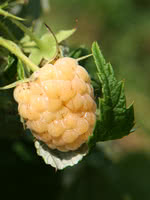Mon-Fri 9am - 5pm Mountain time
Honey Queen Raspberry vs Grouseberry
Rubus x Honey Queen
Vaccinium scoparium
CUSTOM GROW
Honey Queen Raspberry is known for its sweet honey flavor and unique yellow color. Its berries are soft and medium-sized, nice for picking and eating in the summer.
Honey Queen was developed in Rocky Mountain House by Robert Erskine and is very winter hardy. Canes are yellowish, floricane, arched and moderately spiny.
Honey Queen should be trellised upright for best results. While all raspberries prefer the sun, Honey Queen is the best option for planting in shady areas.
The Honey Queen Raspberry is a fast-growing floricane. This means that raspberries will not grow on canes the year they first grow. The mature canes they do grow on, however, produce more berries than primocane varieties.
Check out some video of a Honey Queen Raspberry we saw this summer on our YouTube Channel. Click here.
Grouseberry is a native, low-growing deciduous shrub known for its edible red berries. In early summer, it produces small, urn-shaped flowers ranging from white to pink that attract bees and other pollinators. The berries provide an important food source for many types of wildlife, including game birds such as grouse, which gives the plant its common name. People can also enjoy the berries fresh or in baked goods, though they can be difficult to harvest in large quantities.
Spreading by rhizomes, Grouseberry forms dense, broom-like mats that help stabilize soil and prevent erosion, while also providing cover for ground-nesting wildlife. It is commonly found beneath conifers in open forests, subalpine meadows, and occasionally on rocky slopes in mountainous regions. It is well-suited for naturalization, ecological restoration, and soil stabilization projects.

